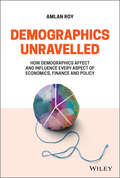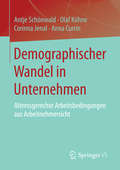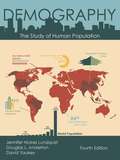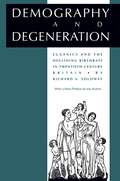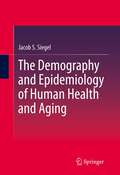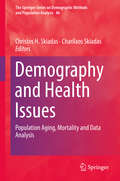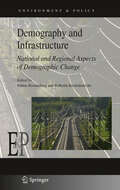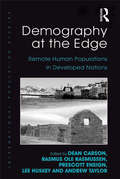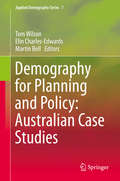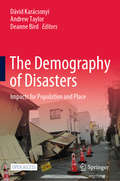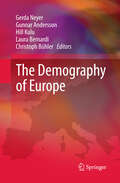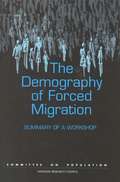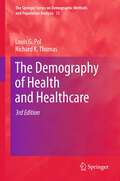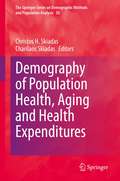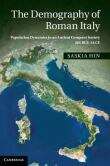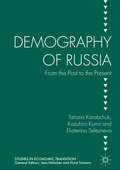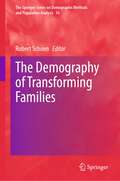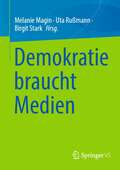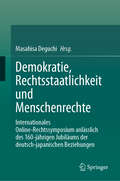- Table View
- List View
Demographics Unravelled: How Demographics Affect and Influence Every Aspect of Economics, Finance and Policy
by Amlan RoyDiscover what demographics can tell us about the economy, markets, and the future In Demographics Unravelled, renowned Macro-Demographics expert Amlan Roy delivers an insightful and timely exploration of the impact that “people characteristics” have on national economies. Considering factors like gender, race, migrant status, family background, and education, the author delves deeply into a subject that drives market behavior and economic variables, including growth, debt, inflation, employment, and productivity. These have national and international policy implications. In this one-of-a-kind book, you’ll discover: Why the study of demographics is the hidden key to understanding economic growth, asset prices, and capital flows How to use detailed demographics to forecast future scenarios in economics, socioeconomics, geopolitics, and the environment The short-, medium-, and long-term effects of consumer and worker behavior How understanding demographics is key to understanding health, pensions, migration, sustainability and social policies. It is intimately linked to the Sustainable Development Goals of the UN—Gender, Climate, Poverty and Inequality Perfect for institutional investors, insurance professionals, economists, and business leaders, Demographics Unravelled will also earn a place in the libraries of academics and students studying a variety of economic disciplines and seeking a one-stop and in-depth discussion of demographics-driven macroeconomic effects.
Demographischer Wandel in Unternehmen
by Antje Schönwald Olaf Kühne Corinna Jenal Anna CurrinDer demographische Wandel verändert nahezu alle Lebensbereiche nachdrücklich. Besonders wirksam wird er in der Arbeitswelt. In der qualitativen wie quantitativen Studie werden Einflüsse auf die Arbeitsfähigkeit älterer Arbeitnehmer in saarländischen Industrieunternehmen aus der Perspektive der Arbeitnehmer selbst untersucht und dabei insbesondere die sogenannten weichen Faktoren wie Arbeitsklima, Zufriedenheit, Wohlbefinden, Partizipation oder Ansprüche an Führungskräfte, berücksichtigt. Damit richtet sich das Buch insbesondere an Personalverantwortliche, Betriebsräte, aber auch an WissenschaftlerInnnen, die sich mit dem demographischen Wandel, insbesondere in der Arbeitswelt, befassen.
Demography: The Study of Human Population
by Jennifer Hickes Lundquist Douglas L. Anderton David Yaukey<p>The population processes in which we all participate are compared, contrasted, and synthesized into understandable trends in the latest edition of this widely acclaimed text. The authors' cogent analysis encompasses demographic milestones like surpassing the seven billion population mark and becoming a majority urban population for the first time in human history, as well as the repercussions of a global financial crisis and the implications of two important ongoing trends: aging and fertility decline. <p>New data, examples, and discussions of emerging demographic issues are incorporated throughout the value-priced Fourth Edition, along with graphics that highlight trends and facilitate comparisons among world regions. This pedagogically rich volume also includes propositions for debate and end-of-chapter exercises that allow readers to become comfortable with the quantitative tools that demographers use to measure and describe populations. Moreover, users will learn about some of the people behind the research that informs this text in a new feature called Careers in Demography. <p>Demography: The Study of Human Population, 4/E, has a companion website developed by the authors. Readers can access the text's data tables, exercises, and figures at demographytextbook.com. They also will find links to many of the reports, articles, and data files referenced in the text.</p>
Demography and Degeneration
by Richard A. SolowayRichard Soloway offers a compelling and authoritative study of the relationship of the eugenics movement to the dramatic decline in the birthrate and family size in twentieth-century Britain. Working in a tradition of hereditarian determinism which held fast to the premise that "like tends to beget like," eugenicists developed and promoted a theory of biosocial engineering through selective reproduction. Soloway shows that the appeal of eugenics to the middle and upper classes of British society was closely linked to recurring concerns about the relentless drop in fertility and the rapid spread of birth control practices from the 1870s to World War II.Demography and Degeneration considers how differing scientific and pseudoscientific theories of biological inheritance became popularized and enmeshed in the prolonged, often contentious national debate about "race suicide" and "the dwindling family." Demographic statistics demonstrated that birthrates were declining among the better-educated, most successful classes while they remained high for the poorest, least-educated portion of the population. For many people steeped in the ideas of social Darwinism, eugenicist theories made this decline all the more alarming: they feared that falling birthrates among the "better" classes signfied a racial decline and degeneration that might prevent Britain from successfully negotiating the myriad competive challenges facing the nation in the twentieth century.Although the organized eugenics movement remained small and elitist throughout most of its history, this study demonstrates how pervasive eugenic assumptions were in the middle and upper reaches of British society, at least until World War II. It also traces the important role of eugenics in the emergence of the modern family planning movement and the formulation of population policies in the interwar years.
The Demography and Epidemiology of Human Health and Aging
by Jacob S. SiegelWith this book, Siegel, an internationally known demographer and gerontologist, has made a unique contribution to the fledgling fields of health demography, and the demography and epidemiology of aging. The book represents a felicitous union of epidemiology, gerontology, and demography, and appears to be the first and only comprehensive text on this subject now available. Drawing on a wide range of sciences in addition to demography, gerontology, and epidemiology, including medical sociology, biostatistics, public policy, bioethics, and molecular biology, the author treats theoretical and applied issues, links methods and findings, covers the material internationally, nationally, and locally, and while focusing on the elderly, treats the entire life course. The methods, materials, and pespectives of demography and epidemiology are brought to bear on such topics as the prospects for future increases in human longevity, the relative contribution of life style, environment, genetics, and chance in human longevity, the measurement of the share of healthy years in total life expectancy, the role of population growth in the rising costs of health care, and the applications of health demography in serving the health needs of local communities. The separate chapters systematically develop the topics of the sources and quality of health data; mortality, life tables, and the measurement of health status; the interrelationships of health, on the one hand, and mortality, fertility, migration, and age structure, on the other; health conditions in the less developed countries; the concepts and theories of aging and projections of the aged population; and local health applications, public health policy, and bioethical issues in health demography. Given its comprehensiveness, clarity, interdisciplinary scope, and authencity, this book appeals to a wide range of users, from students and teachers of medical sociology, the demography of aging, and public health studies to practitioners in these areas, both as a text in health demography and the demography/epidemiology of aging, and as a reference work in these fields.
Demography and Health Issues: Population Aging, Mortality And Data Analysis (The\springer Series On Demographic Methods And Population Analysis Ser. #46)
by Charilaos Skiadas Christos H. SkiadasThis book provides new theories, applications and quantitative methods in demography, population studies and statistics. It presents and applies data analysis, statistics and stochastic modeling techniques focusing on demography, population aging, mortality and health sciences. The book describes diverse stochastic processes as well as Markov and semi-Markov models in demography and population studies, along with chapters on statistical models and methods in biostatistics and epidemiology. As such the book will be a valuable source to demographers, health scientists, statisticians, economists and sociologists.
Demography and Infrastructure
by Wilhelm Kuckshinrichs Tobias KronenbergPopulation ageing has been going on for many decades, but population shrinking is a rather new phenomenon. The population of Germany, as in many other countries, has passed a plateau and is currently shrinking. Demographic change is a challenge for infrastructure planning due to the longevity of infrastructure capital and the need to match supply and demand in order to ensure cost-efficiency. This book summarises the findings of the INFRADEM project team, a multidisciplinary research group that worked together to estimate the effects of demographic change on infrastructure demand. Economists, engineers and geographers present studies from top-down and bottom-up perspectives, focusing on Germany and two selected regions: Hamburg and Mecklenburg-Western Pomerania. The contributors employed a broad range of methods, including an overlapping-generations model for Germany, regional input-output models, an energy systems model, and a spatial model of the transportation infrastructure.
Demography and the Graeco-Roman World
by April Pudsey Claire HolleranThrough a series of case studies this book demonstrates the wide-ranging impact of demographic dynamics on social, economic and political structures in the Graeco-Roman world. The individual case studies focus on fertility, mortality and migration and the roles they played in various aspects of ancient life. These studies - drawn from a range of populations in Athens and Attica, Rome and Italy, and Graeco-Roman Egypt - illustrate how new insights can be gained by applying demographic methods to familiar themes in ancient history. Methodological issues are addressed in a clear, straightforward manner with no assumption of prior technical knowledge, ensuring that the book is accessible to readers with no training in demography. The book marks an important step forward in ancient historical demography, affirming both the centrality of population studies in ancient history and the contribution that antiquity can make to population history in general.
Demography at the Edge: Remote Human Populations in Developed Nations (International Population Studies)
by Rasmus Ole Rasmussen Prescott Ensign Lee HuskeyAddressing the methodological and topical challenges facing demographers working in remote regions, this book compares and contrasts the research, methods and models, and policy applications from peripheral regions in developed nations. With the emphasis on human populations as dynamic, adaptive, evolving systems, it explores how populations respond in different ways to changing environmental, cultural and economic conditions and how effectively they manage these change processes. Theoretical understandings and policy issues arising from demographic modelling are tackled including: competition for skilled workers; urbanisation and ruralisation; population ageing; the impacts of climate change; the life outcomes of Indigenous peoples; globalisation and international migration. Based on a strong theoretical framework around issues of heterogeneity, generational change, temporariness and the relative strength of internal and external ties, Demography at the Edge provides a common set of approaches and issues that benefit both researchers and practitioners.
Demography for Planning and Policy: Australian Case Studies
by Tom Wilson Elin Charles-Edwards Martin BellThis edited collection shows how demographic analysis plays a pivotal role in planning, policy and funding decisions in Australia. Drawing on the latest demographic data and methods, these case studies in applied demography demonstrate that population dynamics underpin the full spectrum of contemporary social, economic and political issues. The contributors harness a range of demographic statistics and develop innovative techniques demonstrating how population dynamics influence issues such as electoral representation, the distribution of government funding, metropolitan and local planning, the provision of aged housing, rural depopulation, coastal growth, ethnic diversity and the well-being of Australia's Indigenous community. Moving beyond simple statistics, the case studies show that demographic methods and models offer crucial insights into contemporary problems and provide essential perspectives to aid efficiency, equity in public policy and private sector planning. Together the volume represents essential reading for students across the social sciences as for policy makers in government and private industry.
Demography: An Introduction to Population Studies (Springer Texts in Social Sciences)
by Richard K. ThomasThis textbook presents an overview of the field of demography from a contemporary perspective. Designed as an introductory text for undergraduates and graduates, it lays out the basic concepts, methods, and applications of the field of demography. It describes the unique characteristics of the field, reviews the basic demographic processes, and provides an overview of the analytical techniques utilized by population scientists. It emphasizes the applied nature of demography and includes a chapter on application of demography to real-world problems as well as a discussion of population policy. The text is supplemented by ample tables, graphics, and illustrations that illustrate the concepts being considered. Through including exercises as well as detailed information on the sources of demographic data, this textbook is a must have for undergraduate and graduate students in demography and population studies.
The Demography of Blindness Throughout the World
by Hyman Goldstein<P>Most of the world's blindness could be prevented, and the attack on it and its consequences proceeds apace through such organizations as the World Council for the Welfare of the Blind, the International Agency for the Prevention of Blindness, and the World Health Organization. <P>For greatest effectiveness, their programs must be based upon accurate data, as a WHO study quoted here by Dr. Goldstein makes clear: "In order to establish appropriate priorities for prevention and treatment at the national and international level, it is essential that reliable up-to-date statistical data on prevalence, age of onset, and causes of blindness be obtained." <P>But even in the United States, where collection of data on blindness began in 1830, there are still no reliable trend data. In much of the rest of the world data are fragmentary, and data that would allow valid country by country comparisons are almost non-existent. <P>Dr. Goldstein has done a valuable service in pulling together such statistics as can be found, and in discussing their weaknesses and strengths.
The Demography of Disasters: Impacts for Population and Place
by Dávid Karácsonyi Andrew Taylor Deanne BirdThis open access book provides worldwide examples demonstrating the importance of the interplay between demography and disasters in regions and spatially. It marks an advance in practical and theoretical insights for understanding the role of demography in planning for and mitigating impacts from disasters in developed nations. Both slow onset (like the of loss polar ice from climate change) and sudden disasters (such as cyclones and man-made disasters) have the capacity to fundamentally change the profiles of populations at local and regional levels. Impacts vary according to the type, rapidity and magnitude of the disaster, but also according to the pre-existing population profile and its relationships to the economy and society. In all cases, the key to understanding impacts and avoiding them in the future is to understand the relationships between disasters and population change. In most chapters in this book we compare and contrast studies from at least two cases and summarize their practical and theoretical lessons.
The Demography of Europe
by Gunnar Andersson Gerda Neyer Laura Bernardi Christoph Bühler Hill KuluOver the past decades Europe has witnessed fundamental changes of its population dynamics and population structure. Fertility has fallen below replacement level in almost all European countries, while childbearing behavior and family formation have become more diverse. Life expectancy has increased in Western Europe for both females and males, but has been declining for men in some Eastern European countries. Immigration from non-European countries has increased substantially, as has mobility within Europe. These changes pose major challenges to population studies, as conventional theoretical assumptions regarding demographic behavior and demographic development seem unfit to provide convincing explanations of the recent demographic changes. This book, derived from the symposium on "The Demography of Europe" held at the Max Planck Institute for Demographic Research in Rostock, Germany in November 2007 in honor of Professor Jan M. Hoem, brings together leading population researchers in the area of fertility, family, migration, life-expectancy, and mortality. The contributions present key issues of the new demography of Europe and discuss key research advances to understand the continent's demographic development at the turn of the 21st century.
The Demography of Forced Migration: Summary of a Workshop
by Committee on PopulationInformation on The Demography of Forced Migration
The Demography of Health and Healthcare
by Richard K. Thomas Louis G. PolIn this 3rd edition of the definitive work on health demography, Pol and Thomas offer an updated view of the field and a current perspective on the applications of health demography to contemporary issues. The significance of health demography within the field of population studies has continued to increase and this work provides background on the healthcare arena and systematically presents the various aspects of demography as they relate to healthcare. This addition has been streamlined to focus on the important aspects of health demography and enhanced through the addition of charts, maps and other graphics. All statistics and tables have been updated and the most current references are included. A separate chapter on morbidity has been included and the final chapter focuses on the public policy interface with health demography. Case studies and sidebars are included throughout the book to illustrate the applications of demography within the healthcare arena. Recent developments in U.S. healthcare are highlighted to give the text a very contemporary presence.
Demography of Population Health, Aging and Health Expenditures (The Springer Series on Demographic Methods and Population Analysis #50)
by Christos H. Skiadas Charilaos SkiadasThis book provides theoretical and applied material for estimating vital parts of demography and health issues including the healthy aging process along with calculating the healthy life years lost to disability. It further includes the appropriate methodology for the optimum health expenditure allocation. Through providing data analysis, statistical and stochastic methodology, probability approach and important applications, the book explores topics such as aging and mortality, birth-death processes, self-perceived age, life-time and survival as well as pension and labor-force. By providing a methodological approach to health problems in demography and society including and quantifying important parameters, this book is a valuable guide for researchers, theoreticians and practitioners from various disciplines.
The Demography of Remarriage in Japan (SpringerBriefs in Population Studies)
by James M. Raymo Miho Iwasawa Erika Teramoto Shohei Yoda Setsuya FukudaThis book provides the first comprehensive demographic overview of remarriage in Japan. Despite the fact that nearly one in five marriages in Japan now involves at least one formerly married spouse, very little is known about the nature of remarriages and how they differ from first marriages. One important focus of this book is to examine fertility intentions and outcomes in remarriages and to compare them with marriages in which both partners are in their first marriage. It is well known that low rates of first marriage contribute to Japan’s very low total fertility rate (TFR), but there is currently no theoretical or empirical basis for understanding how levels and patterns of remarriage are related to the TFR. To understand trends and patterns of remarriage in Japan, the book begins with an overview of the voluminous research literature on remarriage in the USA and other Western countries. This overview consists of a summary of trends and theoretical frameworks for understanding remarriage and is followed by a summary of existing research on correlates of remarriage and outcomes associated with higher-order marriages. Of particular importance is the attention paid to stepfamily fertility and the extent to which remarriage is associated with overall levels of fertility. An important contribution of this book is its presentation of basic descriptive information about levels and correlates of remarriage in Japan. These descriptive analyses are based on published data in the vital statistics reports and individual-level data from the National Fertility Surveys conducted by the National Institute of Population and Social Security Research and the National Survey of Households with Children conducted by the Japan Institute for Labour Policy and Training.
The Demography of Roman Italy
by Saskia HinThis book provides a fresh perspective on the population history of Italy during the late Republic. It employs a range of sources and a multidisciplinary approach to investigate demographic trends and the demographic behaviour of Roman citizens. Dr Hin shows how they adapted to changing economic, climatic and social conditions in a period of intense conquest. Her critical evaluation of the evidence on the demographic toll taken by warfare and rising societal complexity leads her to a revisionist 'middle count' scenario of population development in Italy. In tracing the population history of an ancient conquest society, she provides an accessible pathway into Roman demography which focuses on the three main demographic parameters - mortality, fertility and migration. She unites literary and epigraphic sources with demographic theory, archaeological surveys, climatic and skeletal evidence, models and comparative data. Tables, figures and maps enable readers to visualise the quantitative dynamics at work.
Demography of Russia
by Tatiana Karabchuk Kazuhiro Kumo Ekaterina SeleznevaThis book examines the demographic development of Russia from the late Russian Empire to the contemporary Russian Federation, and includes discussions of marriage patterns, fertility, mortality, and inter-regional migration. In this pioneering study, the authors present the first English-language overview of demographic data collection in Russia. Chapters in the book offer a systematic overview of the legislation regulating fertility and the family sphere, a study of the factors determining first and higher order births, and an examination of population distribution across Russian regions. The book also combines research tools from the social sciences with a medical approach to provide a study of mortality rates. By bringing together approaches from several disciplines - demography, economics, and sociology - the authors of this book provide a comprehensive and detailed assessment of the historical roots of Russia's demographic development.
Demography of the Dobe !Kung
by Robert GutmanFirst published in 1979, this is a classic study of the population of the Bushmen of the Kalahari Deselt of Botswana. Using methods that are simple and fully illustrated, the author presents empirical descriptions of the fertility, mortality, and marriage patterns of the now famous !Kung hunter-gatherers.The !King "Bushman" people of the Kalahari desert in Africa occupy an anomalous position in the world of science. They have been selected for intensive study precisely because they are geographically, socially, and economically removed from modern, industrialized society, living in a sparsely settled and remote portion of an enormous semidesert. The !Kung maintain the language and culture of a fully develop hunting and gathering society with (until very recently) no dependence on cultivated plants, no domesticated animals other than the dog, no stratification system based on kinship or occupation, no power or authority structure extending further than the local bands composed of a few related families, no wage labor, no use of money, and no settled sites of occupation.At the same time, the !Kung have become well-known figures to students—both undergraduate and professional—of Western social science. The faces of !Kung informants gaze from the covers and the illustrations of many texts in anthropology and sociology.Why has all this attention been developed around the !Kung people? Part of the answer lies in the people themselves. The !Kung are a physically attractive people, with slender, graceful bodies and open small-featured faces that are appealing and photogenic. Their culture is simple and has its striking features. The struggle for subsistence, the click language, the emphasis on sharing and humility, the drama of the curing dances in which individuals go into trance and speak directly to spirits to cure sickness, and the pervasive humor, teasing, and playfulness of the !Kung style are all features that are relatively easy to convey and interesting to l earn about.This work covers areas such as marriage, fertility, disease, mortality, history, and the projected future of the !Kung. This book will be of interest to students of demographic studies, anthropology, and African studies.
The Demography of Transforming Families (The Springer Series on Demographic Methods and Population Analysis #56)
by Robert SchoenThis book provides an up-to-date survey on the nature, causes, and patterns of family change. The traditional nuclear family has been replaced by a multiplicity of other forms, as widespread cohabitation, high levels of divorce and union dissolution, rising childlessness, and far below replacement fertility have emerged to an extent never before seen. Theoretical perspectives on this “Second Demographic Transition” are presented, highlighting the dramatic changes in gender roles. New methodological strategies for assessing family dynamics are presented, from multistate models of marriage and divorce combined with fertility to improved techniques for combining census and survey data on the family to a new approach for disentangling age, period, and cohort effects. While the volume emphasizes Western nations, insightful case studies range from analyzing family complexity in cohorts of parents and children in the UK to the impact of interpartner violence on family formation, to the emergence of a “gender war” in South Korea. By providing new insights into where we are today and how we got here, the book will be of value to all those interested in the contemporary family."Delayed Fertility as a Driver of Fertility Decline?" available open access under a Creative Commons Attribution 4.0 International License via link.springer.com.
Demography of Transgender, Nonbinary and Gender Minority Populations
by Amanda K. Baumle Sonny NordmarkenThis book provides the first compilation of demographic research focused on transgender, nonbinary, and gender minority populations. It discusses the measurement and conceptualization challenges that shape demographic knowledge of these populations, including how we capture gender on surveys. It examines our current knowledge of demographic characteristics and health disparities and outcomes. Overall, this research demonstrates the increasing knowledge of gender variation at the population level. At the same time, it reveals the need for better survey questions, additional data, and inquiry into a broader subset of demographic questions for these populations as there is little understanding of fundamental demographic information, including migration or spatial distribution of transgender populations, fertility and household structure, labor market outcomes, or broader patterns of morbidity and mortality. The research set forth in this book lays the groundwork for a trans demography that would produce population-level knowledge of these populations and points researchers and policymakers toward needed areas of research, conceptualization, and data collection.
Demokratie braucht Medien
by Melanie Magin Uta Rußmann Birgit StarkFreie und unabhängige Medien sind die Grundlage einer lebendigen Demokratie. In normativen Demokratiemodellen wird die „Wächterrolle“ von Medien betont, weil neben der Kontroll- und Informationsfunktion der Medien ihr Beitrag zur Legitimierung politischer Prozesse als zentral angesehen wird. Medien unterliegen jedoch im digitalen Wandel einem hohen Anpassungsdruck: Sie drohen ihre traditionelle Gatekeeper-Rolle zu verlieren und konkurrieren mit globalen Tech-Giganten wie Facebook und Google um Werbegelder und die Aufmerksamkeit des Publikums. Die Plattformisierung der Medien stellt nicht nur die Vermittlungsleistungen professioneller journalistischer Informationsanbieter in Frage, sondern auch die Rolle der Medien in der Herstellung von Öffentlichkeit. Der Band hinterfragt die sich wandelnde Rolle der Medien im politischen System sowie das Verhältnis von Medien und Politik kritisch. Funktionen und Autonomiegrad von Medien und Journalismus werden analysiert. Mithilfe von Zeitvergleichen werden tiefgreifende Veränderungen wie auch Konstanten herausgearbeitet. Nicht zuletzt gilt es zu erörtern, welche Akteure welche Verantwortung tragen und welche Privilegien sie genießen (sollten).
Demokratie, Rechtsstaatlichkeit und Menschenrechte: Internationales Online-Rechtssymposium anlässlich des 160-jährigen Jubiläums der deutsch-japanischen Beziehungen
by Masahisa DeguchiDas Buch basiert auf den Ergebnissen eines internationalen Online-Rechtssymposium anlässlich des 160-jährigen Jubiläums der deutsch-japanischen Beziehungen und setzt sich mit hochaktuellen Fragen zu Demokratie, Rechtsstaatlichkeit und Menschenrechten auseinander. Im ersten Teil steht die Gewährleistung der Grundrechte von Gläubigern und Schuldnern in der deutschen Zwangsvollstreckung sowie Frage- und Antwortrunden zwischen Wissenschaftlern und Praktikern aus der Perspektive des japanischen Zwangsvollstreckungsrechts im Mittelpunkt. In Teil 2 befassen sich Rechtswissenschaftlern und -praktikern aus Deutschland, Japan, Großbritannien und anderen Ländern mit der Bedeutung und den Problemen der Sportschiedsgerichtsbarkeit aus der Perspektive der grundlegenden Menschenrechte. Der dritte Teil behandelt die Corona-Pandemie aus verfassungsrechtlicher, zivilrechtlicher, strafrechtlicher, konkursrechtlicher und arbeitsrechtlicher Sicht. Im vierten Teil beschäftigen sich Rechtswissenschaftler und -praktiker aus Japan, Deutschland, Korea und den Niederlanden mit Fragen der Harmonisierung von Verfassungs- und Verfahrensgrundsätzen im Zuge der Digitalisierung von Zivilprozessen, die sich seit der Corona-Pandemie rasant ausgebreitet hat. Teil 5 geht abschließend auf die Bedeutung des vergleichenden Prozessrechts für die Entwicklung des Zivilprozessrechts in der Welt, sowohl aus theoretischer als auch aus praktischer Sicht ein.
